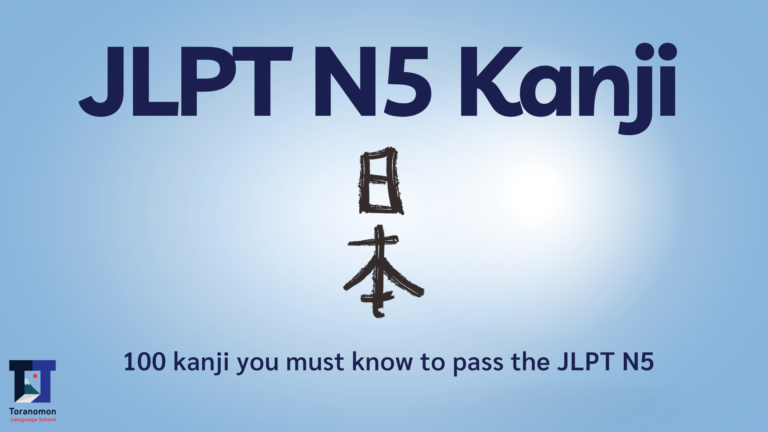JLPT N5 Kanji List
If you are studying for the JLPT N5 test you will need to know about 800 vocabulary words and around 100 kanji characters, as well as hiragana and katakana.
What is the JLPT N5?
The JLPT N5 (Japanese Language Proficiency Test Level N5) is the most basic level of the JLPT and focuses on basic Japanese language skills.
Here is a list of the most basic 100 kanji that you should learn for the JLPT N5. If you are struggling to remember the kanji, it may be helpful to try a lesson with a teacher who can help you with strategies for memorizing the meanings and readings, along with answering any questions that you have.
The kanji
Numbers
一 (ichi) – one
二 (ni) – two
三 (san) – three
四 (shi/yon) – four
五 (go) – five
六 (roku) – six
七 (shichi/nana) – seven
八 (hachi) – eight
九 (kyuu/ku) – nine
十 (juu) – ten
百 (hyaku) – hundred
千 (sen) – thousand
万 (man) – ten thousand
円 (en/maru) – yen, circle
Days/time
半 (han/naka) – half
週 (shuu) – Week
月 (getsu/tsuki) – Month, moon
火 (ka) – Tuesday
水 (sui) – Wednesday
木 (moku) – Thursday
金 (kin) – Friday
土 (do) – Saturday
日 (nichi/hi) – Sun, day
年 (nen/toshi) – Year
時 (ji/toki) – Time, hour
間 (kan/aida) – Time span, between
分 (fun/wakaru) – Minute, to divide
午 (go) – Noon
前 (zen) – Before
後 (go/ato) – After, later, behind
今 (ima) – Now
先 (sen) – Before, ahead, future
来 (rai) – To come
休 (kyuu/yasumi) – rest/vacation
Basic directions/place names
上 (ue) – up
下 (shita) – down
右 (migi) – right
左 (hidari) – left
道 (dou/michi) – street
国 (kuni) – Country
駅 (eki) – Station
社 (sha/yashiro) – Shrine/Company
店 (mise/ten) – Shop
外 (soto/gai) – Outside
学 (gaku) – Learning
校 (kou) – School
中 (naka) – Middle/Centre
北 (kita) – North
南 (minami) – South
東 (higashi) – East
西 (nishi) – West
Commonly used nouns
毎 (mai) – Every, each
何 (ka) – What, which, how many
人 (jin/hito) – person
男 (otoko) – Man
女 (onna) – Woman
子 (ko) – Child
母 (haha) – Mother
父 (chichi) – Father
友 (tomo) – Friend
本 (hon) – book
口 (kuchi) – mouth
出 (deru) – exit
手 (te) – Hand
山 (yama) – Mountain
車 (kuruma) – Car
雨 (ame) – Rain
足 (ashi) – Foot/Leg
本 (hon) – Book
語 (go/kataru) – word/language
川 (kawa) – River
名 (na) – Name
空 (sora) – Sky
気 (ki) – Spirit
魚 (sakana) – Fish
目 (me/moku) – Eye
花 (hana) – Flower
耳 (mimi) – Ear
天 (ten) – Heaven
電気 (denki) – Electricity
Commonly used verbs
行 (iku) – to go
来 (kuru) – to come
見 (miru) – to see
食 (tabe) – to eat
読 (yomi) – to read
生まれる (umareru) – To be born
立つ (tatsu) – To stand
聞く (kiku) – To hear
書く (kaku) – To write
読む (yomu) – To read
話す (hanasu) – To talk
買う (kau) – To buy
行く (iku) – To go
入る (hairu/ireru) – To enter/insert
食べる (taberu) – To eat
飲む (nomu) – To drink
言う (iu) – To say
会う (au) – To meet
Commonly used adjectives
新しい (atarashii) – New
古い (furui) – Old
赤い (akai) – Red
多い (ooi) – A lot/Many
少ない (sukunai) – A little/Few
大きい (ookii) – Big
小さい (chiisai) – Little
安い (yasui) – Cheap/Easy
高い (takai) – Expensive/High
長い (nagai) – Long
白い (shiroi) – White
青い (aoi) – Blue
黒い (kuroi) – Black
緑 (midori) – Green
What is the best way to learn these N5 kanji?
While this list shows the kanji that you should learn, there are actually two+ readings for each kanji. The “onyomi” and “kunyomi” readings. You need to know the main readings for all the kanji, and that tends to be harder than remembering what the kanji actually means. If you join a beginner Japanese class at TLS, your teacher will provide you with handouts featuring all of these kanji along with the readings that you need to know. You should make flashcards as well, either by hand or by using a digital version of which there are many apps for (eg Anki).
These are just some examples of basic kanji characters that you might encounter in the JLPT N5 exam. It’s important to note that the N5 test primarily focuses on hiragana and katakana, so while knowing these kanji characters can be helpful, you should also prioritize mastering hiragana and katakana and understanding basic vocabulary and grammar.

